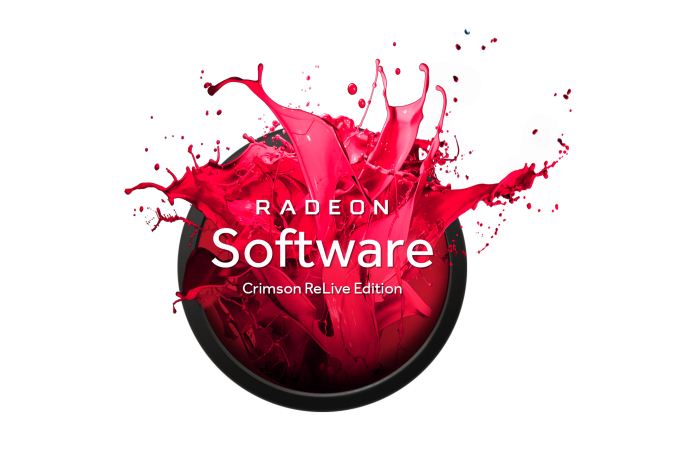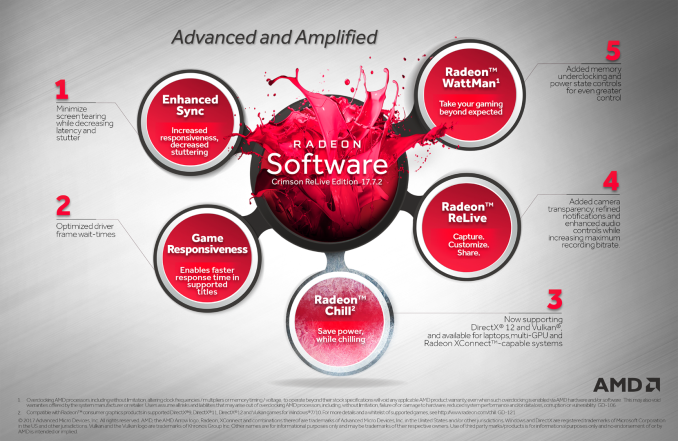AMD Releases Radeon Software Crimson ReLive Edition 17.7.2: ReLive Edition Refined for Gamers and Developers
by Nate Oh on July 26, 2017 5:00 PM EST
It’s been roughly 7 months since AMD released the Crimson ReLive Edition update for Radeon Software, the latest entry in their annual cadence for major driver revisions and feature additions. Today’s launch sees AMD/RTG bring the sequentially and demurely named “Radeon Software Crimson ReLive Edition 17.7.2,” but for all intents and purposes 17.7.2 serves as a major feature revamp to the original Crimson ReLive Edition, as well as refinement of Radeon ReLive and Radeon Chill. In addition to performance optimizations and feature changes, 17.7.2 also introduces AMD’s new Enhanced Sync (comparable to NVIDIA’s Fast Sync and Adaptive V-Sync) and Radeon GPU Profiler, a low-level GCN hardware tracing developer tool.
Taking a step back, 17.7.2 adds to the regular pace of AMD’s graphics overhauls in recent years: Catalyst Omega (12/2014), Radeon Software Crimson Edition (11/2015), and Radeon Software Crimson ReLive Edition (12/2016). While not a wholly new Radeon Software edition, 17.7.2 does show a commitment to improving graphics software features outside of those yearly ‘all-in-one wonder drivers,’ building on AMD’s ongoing efforts to improve user experience. On that topic, AMD today is also launching the Radeon Software Vanguard Beta Tester program.
Overview of Radeon Software 17.7.2: What’s in the Driver?
Similar to the original Crimson ReLive Edition, AMD has broadly outlined 17.7.2 into two areas: gamers and game developers. Many of the changes and improvements revolve around previously introduced software features; for readers unfamiliar with the mentioned features, more detailed looks can be found in Ryan and Daniel’s Crimson Edition launch piece, as well as Ian’s Crimson ReLive Edition launch piece.
For gamers, 17.7.2 includes quality-of-life changes for Radeon Software, fulfilling the top two most-voted feature requests: folding in Radeon Additional Settings into Radeon Settings, and bringing back advanced video feature options with new per-display color controls. AMD has also brought some quality-of-life and recording improvements to Radeon ReLive, as well as broader support for Radeon Chill in terms of more games/APIs and more GPU configurations (including Radeon XConnect). In the same vein, WattMan has been updated with memory underclocking and “per power state” control, while FRTC has been updated with DX12 and mGPU support. Rounding out these feature enhancements is Radeon Software support for AMD’s new Enhanced Sync, a V-Sync replacement that can mitigate latency and stuttering. Lastly, 17.7.2 brings general driver optimizations, as well as driver frame wait-time and shader caching improvements.
Moving on, the developer oriented changes fall under the GPUOpen umbrella. First off is an update to Open Capture and Analytics Tool (OCAT) – AMD's open source successor to FRAPS – which was introduced in Crimson ReLive. AMD stated that this is largely a stability update, particularly targeting certain misbehaving games, and additionally brings Windows 10 Creators Update support.
The second is a new tool for DX12 and Vulkan applications: Radeon GPU Profiler (RGP). Already in the hands of select developers and partners, RGP takes advantage of GCN hardware thread tracing to allow low-level event tracking and visualization of graphics workloads. In essence, RGP opens up GCN GPUs to developers in a way that compares to console development. RGP works hand-in-hand with another new developer feature, the Radeon Developer Driver (RDD), which allows creation of trace files and access to internal driver settings. As a unified consumer and developer driver, RDD enables RGP to “just work.”
Concluding the new developer features is the AMD LiquidVR 360 SDK. This enables end-to-end GPU-accelerated HEVC 4K x 4K VR video playback, as well as 6-channel spatial audio in the form of Immersive Ambisonic Audio.













30 Comments
View All Comments
nampo - Wednesday, July 26, 2017 - link
There is no "Enhanced Sync" setting in my R9 !Cryio - Thursday, July 27, 2017 - link
It's only for Polaris currently. It will be backported to GCN 1.2 and possibly GCN 1.1 later.Alexvrb - Thursday, July 27, 2017 - link
Wow that's nifty I actually wasn't expecting them to support E-Sync outside of Polaris.ET - Thursday, July 27, 2017 - link
It's nice that AMD has a feedback option, but meanwhile the AMD Issue Reporting Form doesn't work, and I haven't been able to report bugs. (In this case, bad interlaced video playback.)StevoLincolnite - Thursday, July 27, 2017 - link
I half expected a couple of benchmarks somewhere or something. Hah.Oh well. Downloading away. I miss the old GUI though, it was better suited to the PC, interested to see if I notice anything on my RX 580... AMD really needs some decent GPU's and stop playing around in the mid-range though. Vega can't come fast enough.
Threska - Thursday, July 27, 2017 - link
Hopefully with this release Deus Ex: Mankind Divided will lose some of the lag it experiences when ran too long.Alexvrb - Thursday, July 27, 2017 - link
That sounds like either a Deus Ex issue or a "help my system is heatsoaked" issue.novingate - Sunday, July 30, 2017 - link
yesnovingate - Sunday, July 30, 2017 - link
<a href="http://www.novingateco.ir/">درب اتوماتيک</a>bluewaffles - Monday, November 20, 2017 - link
https://bluewafflesdisease.info/ I read the title too fast, for a second I assumed they had tweaked the radeon software interface. I miss the old interface. The one that had a hierarchy on the left and the settings on the right. It was simple, intuitive and easy to use. Even after few years I am